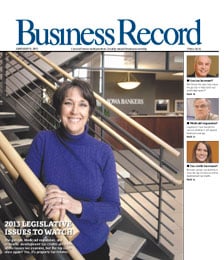Iowa cities increasingly relying on renewable energy technology

FOCUS: TECHNOLOGY
When local officials, state dignitaries and others turn spades of dirt Tuesday to observe Earth Day in Lenox, they won’t be planting a tree – a typical Earth Day activity in communities across the nation. Instead, they will be breaking ground for a new wind turbine, an environmentally friendly power source that will supply 10 percent of the electricity needs of the Taylor County town of 1,400 in extreme Southern Iowa.
Gov. Tom Vilsack, who has made a big push for renewable energy to help fuel the transformation of Iowa’s economy and has asked for $50 million in state investments in renewable energy in the proposed Iowa Values Fund, has been invited to speak at the groundbreaking ceremony. So have U.S. Sen. Charles Grassley, R-Iowa, and Hank Manning, an Iowa Department of Economic Development official who works with the Community Development Block Grant program, which gave Lenox $400,000 toward the $950,000 project.
Dave Ferris, the Lenox Municipal Utilities superintendent, predicts Tuesday will mark the beginning of increasing reliance on “green” power sources. There already are extensive wind farm installations across the northern half of Iowa, but Lenox will become the first community in the southern part of the state to install a wind turbine.
Lenox is located in the second-windiest area of the state along a ridge between the Mississippi and Missouri rivers, and “it’s windy here all the time,” Ferris said.
Closely watching the progress in Lenox are officials with Stuart Municipal Utilities, who are working with the West Central Interstate 80 Development Corp. to secure $400,000 in CDBG funds to install a wind turbine that is expected to supply 13 percent of the electricity needs of Stuart, a community of 1,700. They’re encouraged by the IDED’s approval of the Lenox CDBG application, as well as the agency’s $250,000 grant to Wall Lake Municipal Utilities.
Mike Miller, the IDED’s investment manager of the CDBG program, anticipates action on the Stuart application will occur fairly soon. “Those types of projects are a high priority,” he said. “In essence, we have a special reserve of funding from the feds.”
The state receives about $31 million annually in federal CDBG funds, and holds 5 percent of that money in reserve for projects that meet the criteria for being “bold possibilities” initiatives. Qualifying projects often increase Iowans’ access to renewable energy, but also could be more general community development initiatives, Miller said.
The wind turbine project gives Lenox Municipal Utilities a jump on a Jan. 1, 2004, state-imposed deadline requiring all utilities, whether they be municipal utilities, rural electric cooperatives or investor-owned utilities, to use alternative energy sources to supply part of their power needs. Lenox already purchases 60 percent of its electricity from the Western Area Power Administration, which markets and delivers hydroelectric power generated by a series of federal dams along the Missouri River. With the addition of wind energy, 70 percent of Lenox’s power needs will be supplied by renewable sources, Ferris said.
The looming deadline is causing 137 municipal utility providers around the state to consider their options, said Patti Cale-Fennigan, energy services coordinator for the Ankeny-based Iowa Association of Municipal Utilities.
“There’s a lot of interest in wind energy, and certainly a lot of development going on with wind,” she said. “I think cities are exploring how they fit.”
Some member utilities are exploring buying wind farms, such as the one near Algona shared by seven municipalities. The municipal utilities in Algona and Cedar Falls are the primary owners of that wind farm, but it also generates part of the electricity used in Montezuma, Estherville, Fonda, Westfield and Ellsworth.
“Everybody thinks of wind first, but wind is not going to be feasible for everybody,” Cale-Finnegan said. “They’re looking at what’s appropriate for their communities and what’s workable for their utilities.”
Other options include biodiesel, which would provide more uses for soybeans, and solar photovaltaic technology, which produces electricity from sunlight. Vinton Municipal Utilities is using biodiesel in its diesel generators, and Muscatine Municipal Utilities is exploring additional use of solar power.
Though it’s clean and doesn’t deplete natural resources, the primary argument against wind energy is that it isn’t a reliable source of power. But that could change with technology being developed for the Iowa Stored Energy Plant. It builds on compressed-air energy storage technology, already in use in Germany and Alabama, which stores energy in the form of compressed air in an underground facility to supply future needs. In the Iowa application, wind energy would be used to compress the air, providing a reliable energy source even when the wind isn’t blowing, Cale-Finnegan said.
“If we can do this with wind, it would be the first time anywhere,” she said.
Cale-Finnegan said increasing dependence on renewable sources to supply electricity needs represents “a national and international shift in thinking.”
“The issues of climate change and protecting the environment have become so widely accepted that people are realizing they have to do something to make a difference,” she said. “The renewable technologies have become mature enough and cost-effective enough that they can make a greater contribution now.”







